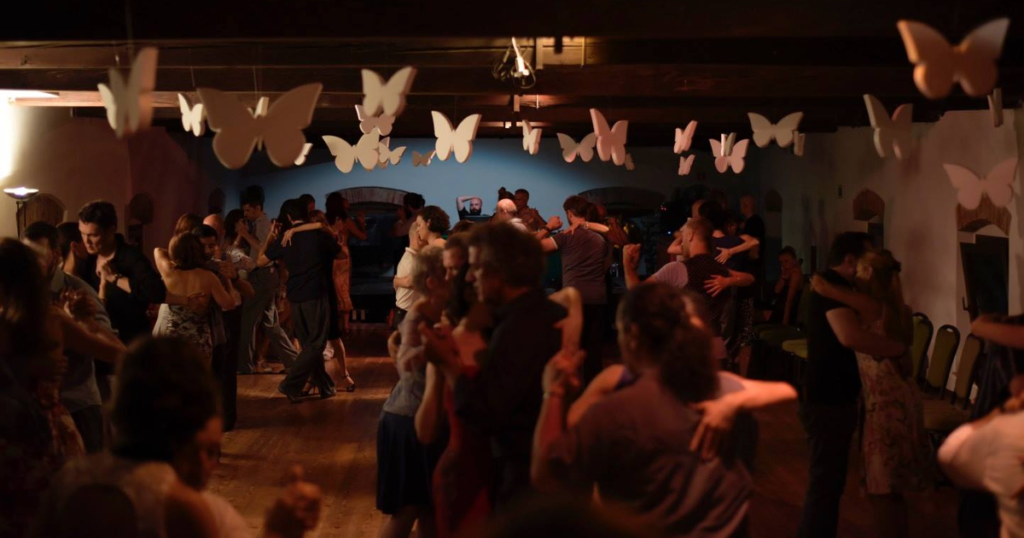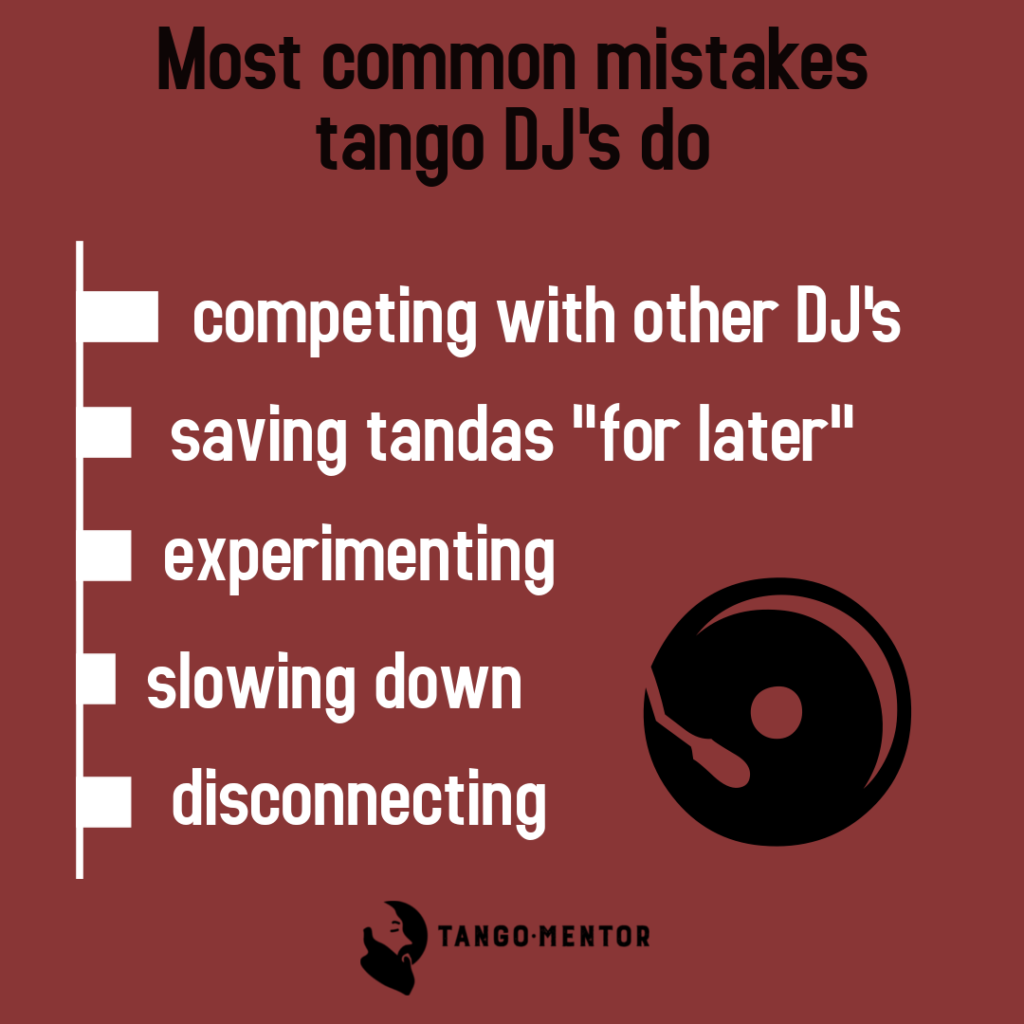
DJ-ing on international tango event is very responsible and demanding task, and if you are not careful enough you might finish up with empty dance floor and disappointed organizer. This is why I decided to write an article about the five most common mistakes that DJs make on international tango events.
It was first published on my tango blog Pocas Palabras and than it went viral – it has been accepted and shared by DJs and organizers on social media, the Slovakian editors of the tango magazine “Gancho” asked me to include it in one of their issues and many people still talk to me about the things said there. I am publishing it here with some minor changes.
Imagine a hundred and more top dancers from all over the world at an elite tango event, traveling maybe 10 hours and spending more than 500 euros for a weekend, just to dance 3 or 4 tandas all night, leaving milonga long before the last tanda.
Strange? Trust me, this happens more often than one can imagine… and all just because of the music.
Being a DJ on international event is quite different than DJing your local milonga – and trust me, the most valuable things are not learned at home. Sometimes even just traveling on international tango events as a dancer is more valuable than DJing your local milonga.
In these years, traveling across Europe almost every month, I have seen good DJs and I have been disappointed by the bad ones; I have been pleasantly surprised by the sets of some people, and been pushed to leave milonga early on by the set of some which are considered good musicalizadores. I learned a lot from my own mistakes as well.
In this 5 points I will try to sublime these lessons, hoping that this post will save some milonga from finishing long before “La Cumparsita”. It will help organizers to recognize good DJs and the DJs to think about their approach.
So, here is what you have to be careful about if you are a DJ on international tango event:
1. Competing with the other DJs at the event
… and therefore, forgetting about the audience. It is not a competition. You do not have to be different, do not try to be better, you do not have to play pieces of music others do not have, do not be original, you do not have to play something they forgot to. If you focus on comparing yourself and your set to others, you completely forget that you are there for the dancers – not for the other fellow DJs. The musicalizador should not be afraid to play some track just because other DJs played it already – if it fits to his/hers concept, it must be on the playlist. Focus on the right things – do not miss the point.

2. Saving the best tandas for “when the right time comes”
The right time usually is when the tanda came in to your mind. Later will be too late. A good DJ, should learn to trust his/hers guts. I learned this the hard way: I saved the perfect tandas for later “when the right time comes” and later was right time for other tandas. This DJing tactics usually results in lowering the quality of your set.
3. Experimenting
International events are places imagined as a point with condensed quality of dance – which means, good dancers and good music. People come to these events and they want to dance, you do not have to surprise them with special music. Of course, it is always nice to refresh the mood with some forgotten or “new” track – but this refreshment should be tested before. This is why international DJs should have their local experience, where they test their tandas. Please, do not screw up the international events for testing your ideas – people traveled thousand of kilometers and spent a lot of money to be there for their dance, not for you to experiment on them.
Hey, sorry to interrupt…
Do you like reading my articles? If you do please consider a small contribution to the existence of this blog.
I don’t sell a book or run ads: I share these articles for free. Unfortunately I also have to pay my bills, so if you see value in my work please consider a small donation/gratuity (the same way you tip your favorite bartender).
From my heart to yours!
Ivica
Securely processed via PayPal
4. Slowing down
I’ve heard this many times and, in my experience, it is nothing but a myth: when the people are tired, you should calm down the energy of your set. As far as I am concerned, the truth is the opposite – when people are tired, the DJ needs to give them extra energy with his/her set. If people are tired, they can dance slow, even on a very energetic music, but nothing drains the mood of the milonga more than slow and passionless music. In my opinion this is number one mood killer on international events.
5. Disconnecting
My personal guiding principle is that “DJing for tango is like dancing with all dancers on the floor at the same time; and making cabeceo with all dancers that are sitting around”. This means that you have to connect with people around and never to forget that you are there for them. I hate to see a DJ’s face glowing from the bright light of the screen of his laptop – the brightness should be enough for him/her to see what is there, but not so much to interfere with his ability to see what is going on around.
Of course this post is not a rule-book. Everyone has his/her own experience and opinion which might be different than mine. If this is the case I would be glad to discuss about them in the comments sections bellow or in email conversation.
Don’t forget to share this with your fellow tango dancers so they could benefit from my experience as well.

Hi: Here are 5 other mistakes tango djs also make far too often (local or international)
– superloud cortinas (or too “danceable” cortinas)
– bad equalization (pushing the mid range to “hear the singer” and cutting the bass)
– “stuck in the golden age” style (no 30s, no 50s music)
– using low quality, skipping, reverbed mp3s when there are better alternatives
– not managing the volume differences between tracks or tandas
Hi Yves, thanks for the comment – you have really good points here – I agree with them all, even in my opinion they are not the most common mistakes…
I would just not agree completely with the third one – I think it is also mistake when DJs play music later than 1950s (or at least more than one tanda) since that music was not made for dancing, but for listening. After the 1950s orchestras moved to radio and TV, to concerts – and their music is not for dancing anymore, their intention was not to make music for dancing. I wrote about this topic in my post about “The principles of danceability”
Yves wote: “stuck in the golden age” style (no 30s, no 50s music)”
Point of information: the Golden Age includes lots of 30s and 50s music.